Abstract
In 2008, the epigraphical evidence for the mid-18th Dynasty king’s daughter
1. The Dossier of Princess Nbw-m-tḫ
In 2008, Dina Faltings and Beatrix Gessler-Löhr published an article about the king’s daughter
Table 1 lists all the objects of
The objects of, or mentioning, the king’s daughter
ID
Collection
Type
Acquisition
Figure
I.1
Leiden, RMO H 329 (AAL 86)
kohl-pot with lid
bought in January 1829 with Anastasi collection
Fig. 1a
I.2
Leiden, RMO H 330 (AAL 87)5
kohl-pot
bought in January 1829 with Anastasi collection
Fig. 1b
I.3
Leiden, RMO H 332 (AAL 88)6
kohl-pot
bought in January 1829 with Anastasi collection
Fig. 1c
I.4
Leiden, RMO H 240 (AAL 20)7
ointment-jar
bought in January 1829 with Anastasi collection
Fig. 1d
I.5
Paris, Louvre N 5078
ointment-jar
bought before 18739
Fig. 2a
I.6
Munich, SMÄK ÄS 243
ointment-jar
bought in 1832 from Dodwell collection
Fig. 2b
I.7
Munich, SMÄK ÄS 247
ointment-jar
bought in 1832 from Dodwell collection (an earlier drawing dates to 1825)10
Fig. 2c
I.8
Turin, Museo Egizio, Inv. 8475 (Orcurti N. 8.)
ointment-jar
acquired before 1855
Fig. 2d
I.9
Turin, Museo Egizio, Inv. 8474 (Orcurti N. 6.)
ointment-jar
acquired before 1855
Fig. 3a
I.10
London, BM EA 453611
ointment-jar
bought in 1845 from Harry Osborn Cureton
Fig. 3b
I.11
Turin, Museo Egizio, no inv.-no. (Orcurti N. 5.?)
ointment-jar with lid
acquired before 1855
–
I.12
Turin, Museo Egizio, no inv.-no. (Orcurti N. 7.?)
ointment-jar with lid
acquired before 1855
–
II
Paris, Louvre N 813 (LP 233)12
Quartzite cosmetic implement
donation of Léon Jean Joseph Dubois before 184613
Fig. 3c
III
London, BM EA 136914
limestone stela of the
purchased in 1902 from Mohammed Mohassib through Rev. Chauncey Murch
Fig. 3d
a: Leiden RMO H 329 (photo: RMO Leiden, CC0).
a: Louvre N 507 (photo: © 2000 Musée du Louvre / Georges Poncet).
a: Turin RGCE 8474 (after Faltings and Gessler-Löhr, in Spiekermann (ed.), FS Schmitz, 2008, pl. VII, fig. 8).
2. The “Lost” Turin Vessels
In listing the collections with objects of
Based on these short descriptions, the connection proposed by Faltings and Gessler-Löhr between the Orcurti-numbers and the objects (see Table 1) can
I.9 = Cat. 3247 (after Fabretti et al., Regio Museo I, 1882, p. 442).
I.8 = Cat. 3248 (after Fabretti et al., Regio Museo I, 1882, p. 442).
A short query in the Turin collection database revealed the whereabouts and inventory numbers of the two “lost” alabaster vessels: I.12 = Cat. 3254 (Fig. 6) and I.11 = Cat. 3255 (Fig. 7). The long-lasting confusion regarding these two objects was caused by an incorrect reference in Fabretti et al., Regio Museo I, 1882, p. 443 in relation to the vessel Cat. 3254, which is said to show the same text as Cat. 3199, a bronze bowl inscribed in the name of a
I.12 = Cat. 3254 (after Fabretti et al., Regio Museo, I, 1882, p. 443).
I.11 = Cat. 3255 (after Fabretti et al., Regio Museo, I, 1882, p. 443).
The vessels of
Petrie MSS 3.1.190, showing vessels I.9 (= Cat. 3247) and I.8 (= Cat. 3248) (© Griffith Institute, Oxford: https://archive.griffith.ox.ac.uk/index.php/petrie-3-1-190).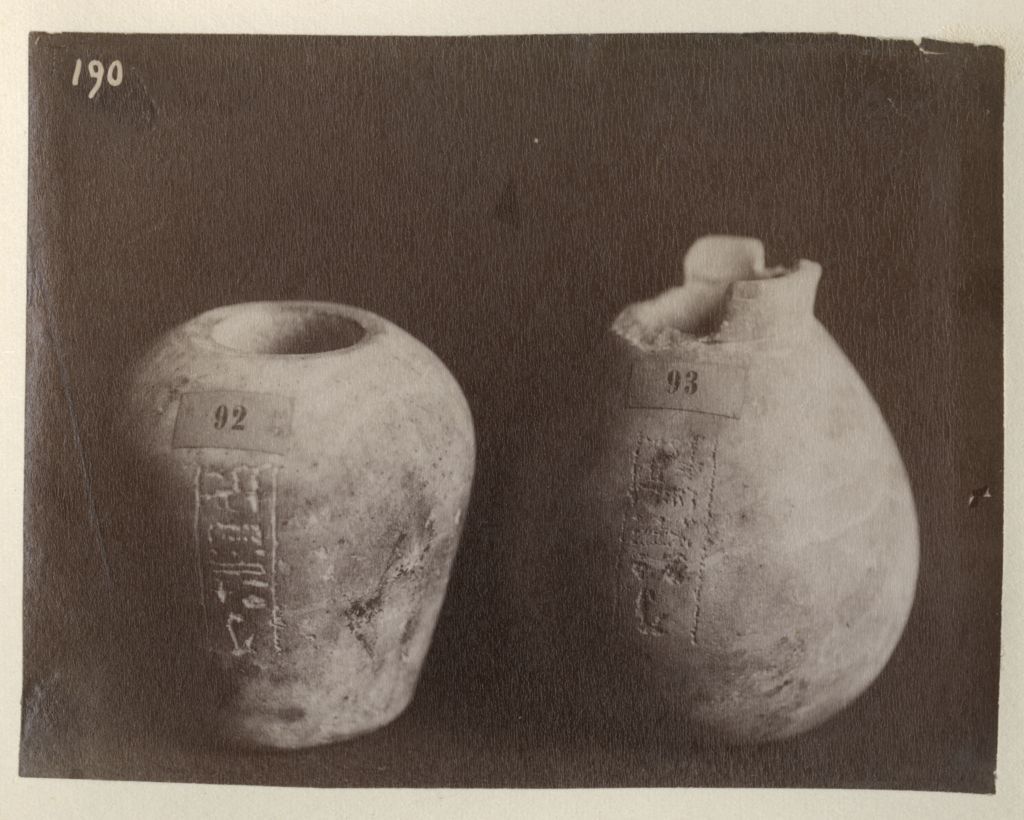
Petrie MSS 3.1.195, showing vessels I.11 (= Cat. 3255) and I.12 (= Cat. 3254) in the front row among other calcite alabaster vessels (upper row Cat. 3277; Cat. 3252; Cat. 3275; lower row left Cat. 3261; right Cat. 3259) (© Griffith Institute, Oxford: https://archive.griffith.ox.ac.uk/index.php/petrie-3-1-195).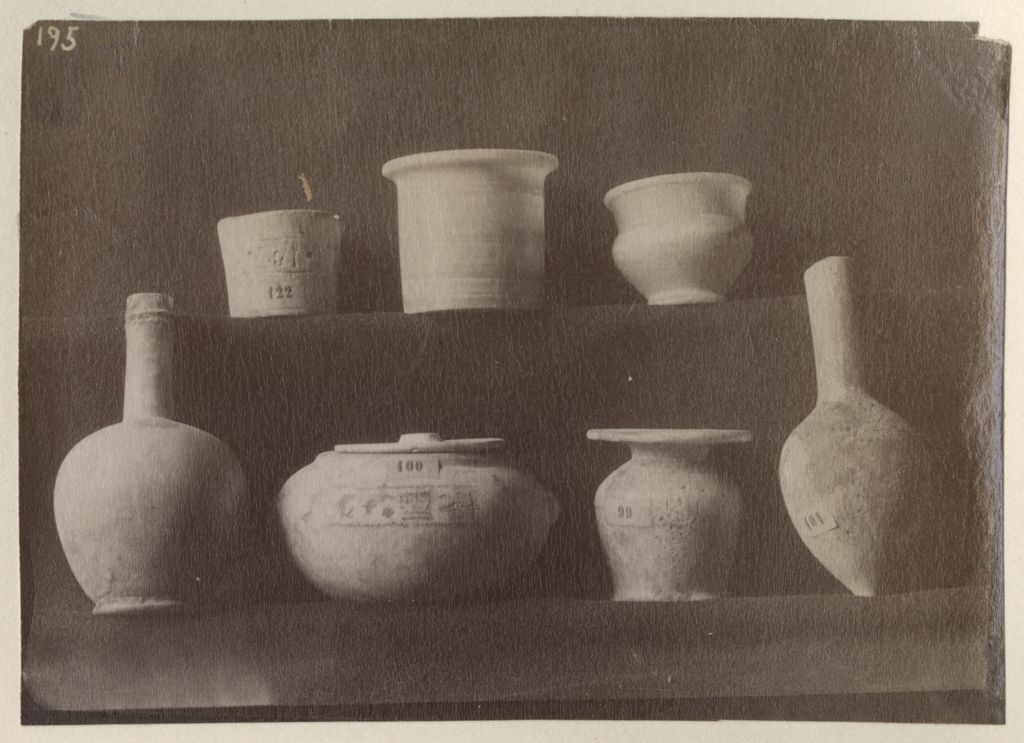
The following table (Table 2) provides a short concordance of the different catalogue, location, and inventory numbers of the four calcite alabaster vessels of
Catalogue and inventory number concordance of the four calcite alabaster vessels of the king’s daughter
Fabretti
Faltings & Gessler-Löhr
Orcurti
‘Location’-No.
RCGE
Cat. 3247
I.9
N.6
92
8474
Cat. 3248
I.8
N.8
93
8475
Cat. 3254
I.12
N.7
99
8481
Cat. 3255
I.11
N.5
100
8482
3. Nbw-m-tḫ ’s Calcite Alabaster Vessels in Turin
The four calcite alabaster vessels of the king’s daughter 
Inventory Number: Cat. 3247 (Figs. 10, 11, 12, 13)
Material: Calcite alabaster, Egyptian blue
Dimensions: height 9.4 cm, max. diam.: 8.85 cm; diam. at base: 5.5 cm; outer diam. of rim: 4.4 cm; inner diam. of mouth 3.2 cm; depth: 7.6 cm; weight: 815.4 g
Acquisition: before 1855 (possibly from Drovetti collection)
Provenance: unknown, probably Saqqara (see below)
Date: mid-18th Dynasty, Thutmose IV – Amenhotep III
Description: Calcite alabaster vessel with a short and flattened rim, rounded shoulder, narrowing body and flat base, and an inscription column engraved on the body. The text reads
References: Orcurti, Catalogo illustrato, 1855, p. 178, N.6; Fabretti et al., Regio Museo I, 1882, p. 442, pl. I, no. 75, Cat. 3247; Maspero, RecTrav 4 (1883), p. 151; Gauthier, RecTrav 40 (1923), p. 202, no. 32; Chassinat, REA 1 (1925), p. 132; Roccati, in Morigi Govi et al. (eds.), L’Egitto fuori dell’Egitto, 1991, p. 362; Bierbrier, Hieroglyphic Texts 12, 1993, p. 26; Faltings and Gessler-Löhr, in Spiekermann (ed.), FS Schmitz, 2008, p. 68, pl. VII, fig. 9, I.9.
Parallels: I.10.
Main views of Turin Cat. 3247 (photos by Nicola Dell’Aquila and Federico Taverni/Museo Egizio).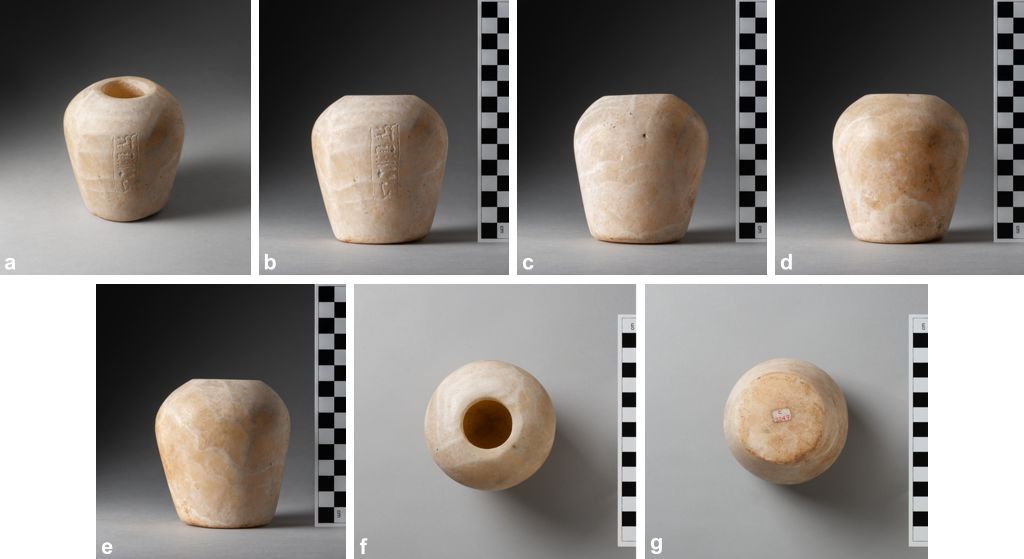
Two views of Turin Cat. 3247 with light shining through (photos by Nicola Dell’Aquila and Federico Taverni/Museo Egizio).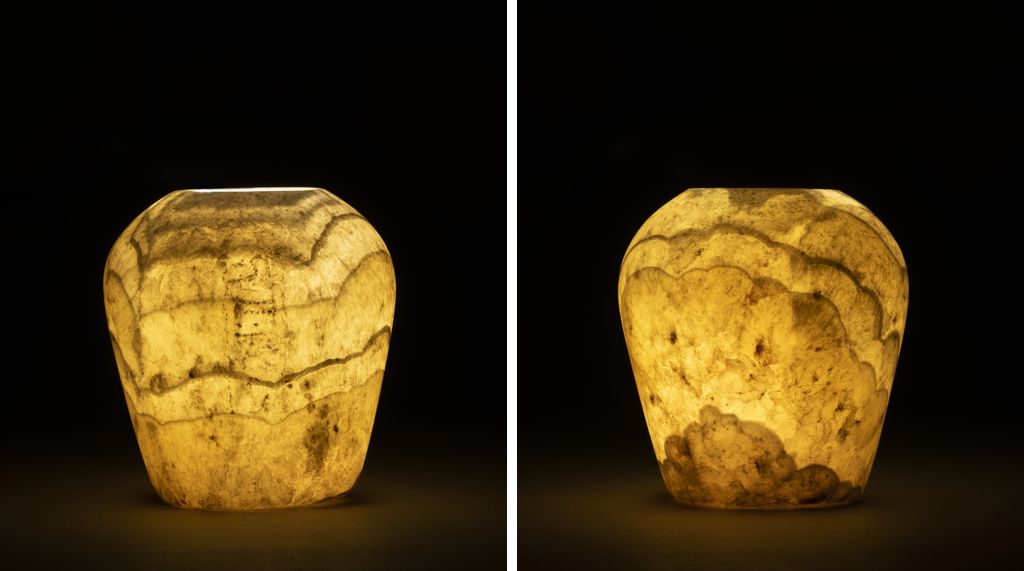
View of the inscription of Cat. 3247 under visible induced luminescence (VIL) (photo by Nicola Dell’Aquila and Federico Taverni/Museo Egizio).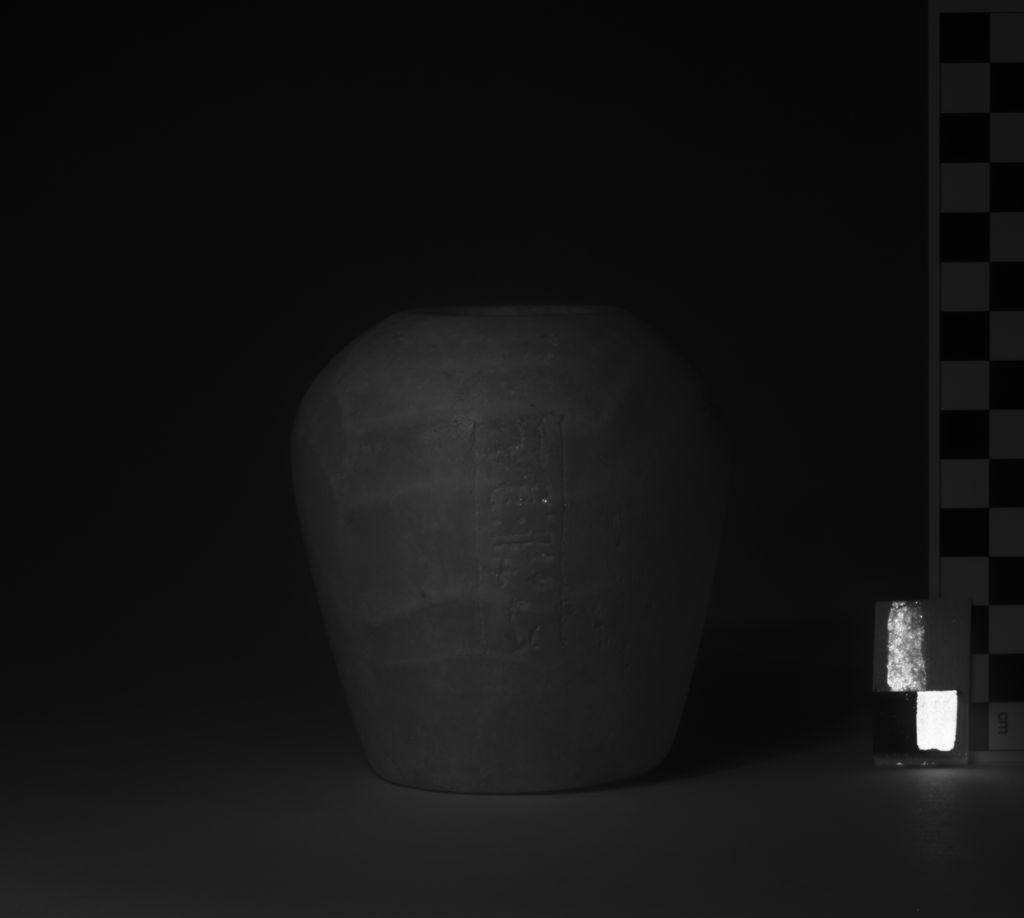
Inventory Number: Cat. 3248 (Figs. 10, 14, 15, 16)
Material: Calcite alabaster, Egyptian blue
Dimensions: height: 11 cm; max. diam.: 9.9; outer diam. of mouth 4.5 cm; inner diam. of mouth 3.65 cm; inner diam. of neck 3.15 cm; max. inner depth measured from upper rim: 9.8 cm; weight: 845 g
Acquisition: before 1855 (possibly from Drovetti collection)
Provenance: unknown, probably Saqqara (see below)
Date: mid-18th Dynasty, Thutmose IV – Amenhotep III
Description: Calcite alabaster vessel with a flat (re-worked?) rim, short cylindrical neck, bag-shaped (or pyriform) body and a flattened base. An inscription column reading
References: Orcurti, Catalogo illustrato, 1855, p. 179, N.8; Fabretti et al., Regio Museo I, 1882, p. 442, Cat. 3248; Roccati, in Morigi Govi et al. (eds.), L’Egitto fuori dell’Egitto, 1991, p. 362; Bierbrier, Hieroglyphic Texts 12, 1993, p. 26; Faltings and Gessler-Löhr, in Spiekermann (ed.), FS Schmitz, 2008, p. 67, pl. VII, fig. 8, I.8.
Parallels: I.4–7; I.8 seems to miss its original rim. The closest parallel for such a vessel with a removed/missing rim is from Aniba: S.10, 47.26 In addition, Aniba no. S.49 can be mentioned: the neck of the vessel is missing and the break appears to have been smoothed.27 Furthermore, the bag-shaped vessel SAC5 211 from Tomb 26, feature 2, a mid- to late 18th Dynasty burial context (thus also corroborating the dating of
Main views of Turin Cat. 3248 (photos by Nicola Dell’Aquila and Federico Taverni/Museo Egizio).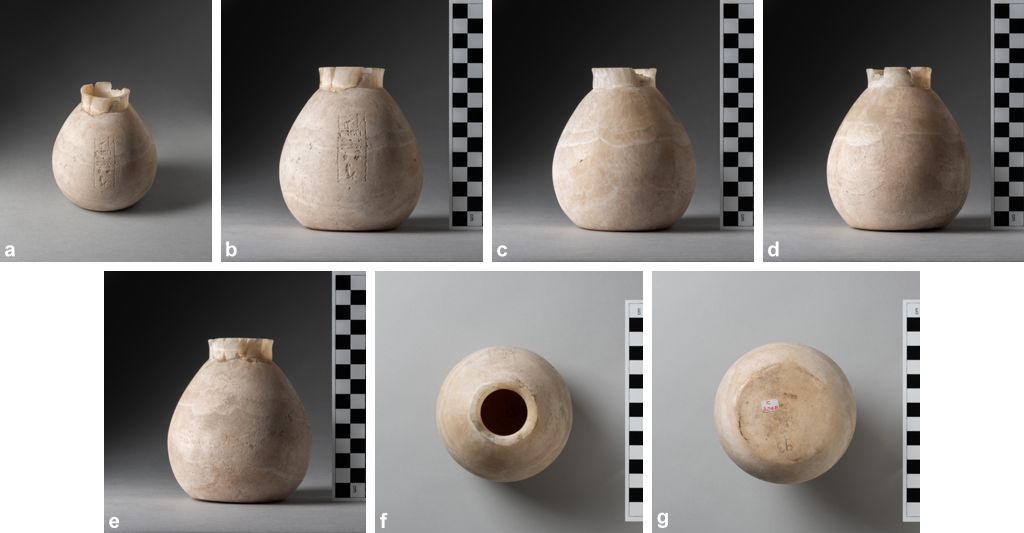
Two views of Turin Cat. 3248 with light shining through (photos by Nicola Dell’Aquila and Federico Taverni/Museo Egizio).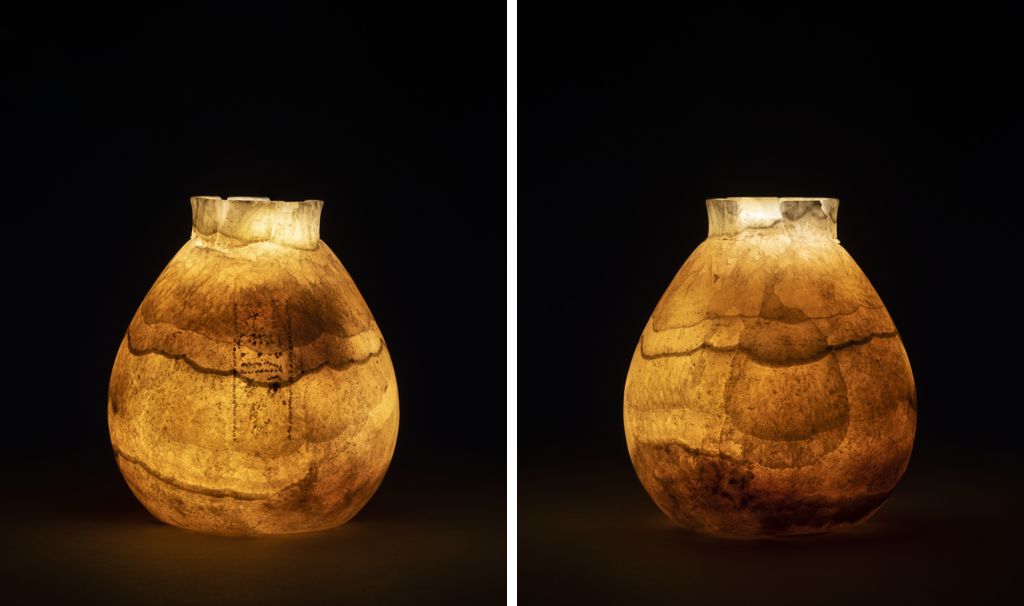
View of the inscription of Cat. 3248 under visible induced luminescence (VIL) (photo by Nicola Dell’Aquila and Federico Taverni/Museo Egizio).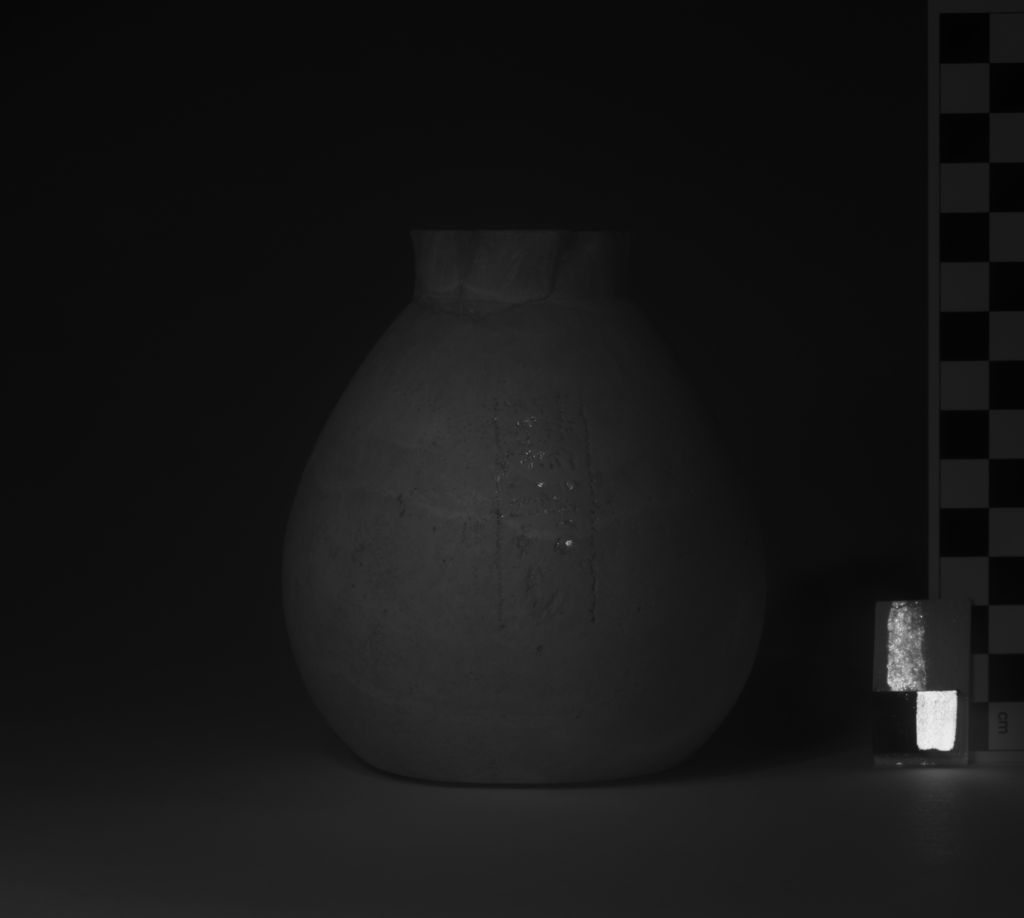
Inventory Number: Cat. 3254 (Figs. 10, 17, 18, 19)
Material: Calcite alabaster, Egyptian blue
Dimensions: height: 8 cm; max. diam. of rim: 7.5; max. diam. of body: 6.8 cm; max. diam. of base ring: 5.3 cm; thickness of rim 0.6 cm; diam. of mouth 2.05 cm; max. inner depth measured from upper rim: 5.95 cm; weight: 506.3 g
Acquisition: before 1855 (possibly from Drovetti collection)
Provenance: unknown, probably Saqqara (see below)
Date: mid-18th Dynasty, Thutmose IV – Amenhotep III
Description: Calcite alabaster vessel with a flat brim, short neck, rounded shoulder, truncated conical body and flattened base. An inscription column reading
References: Orcurti, Catalogo illustrato, 1855, p. 179, N.7; Fabretti et al., Regio Museo I, 1882, p. 443, pl. I, no. 63, Cat. 3254; Faltings and Gessler-Löhr, in Spiekermann (ed.), FS Schmitz, 2008, p. 69, I.12.
Parallels: I.1–3.29
Main views of Turin Cat. 3254 (photos by Nicola Dell’Aquila and Federico Taverni/Museo Egizio).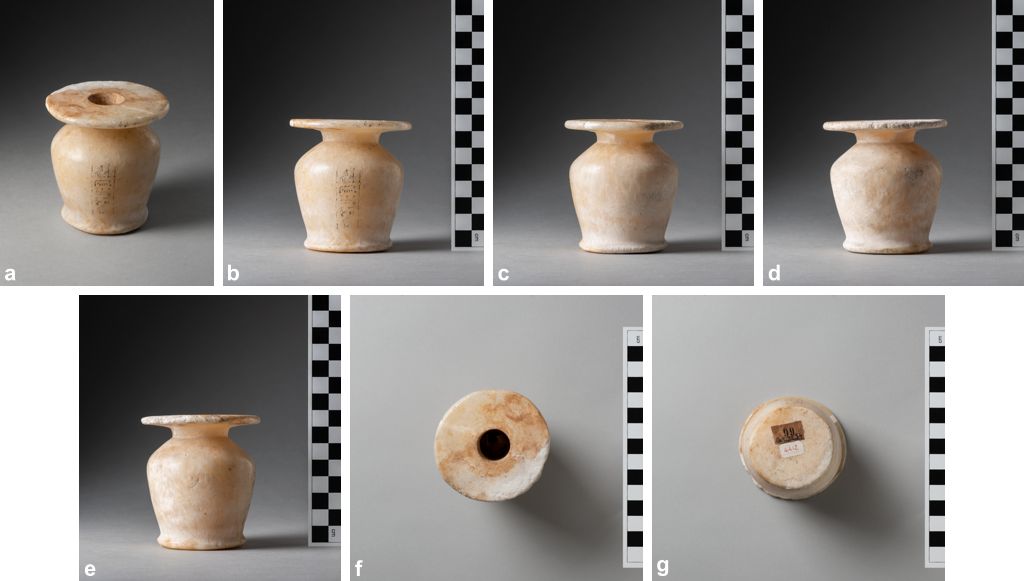
Two views of Turin Cat. 3254 with light shining through (photos by Nicola Dell’Aquila and Federico Taverni/Museo Egizio).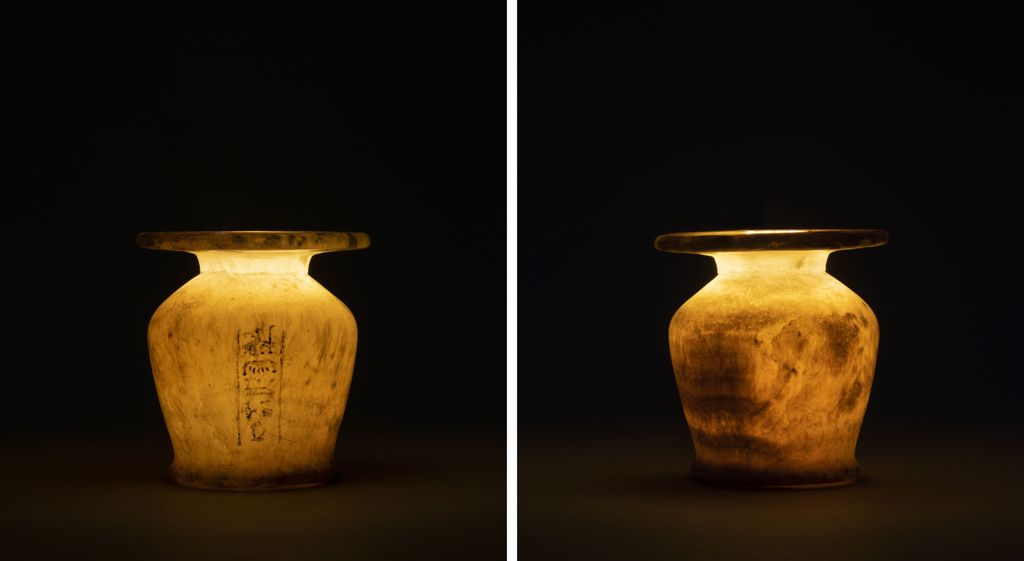
View of the inscription of Cat. 3254 under visible induced luminescence (VIL) (photo by Nicola Dell’Aquila and Federico Taverni/Museo Egizio).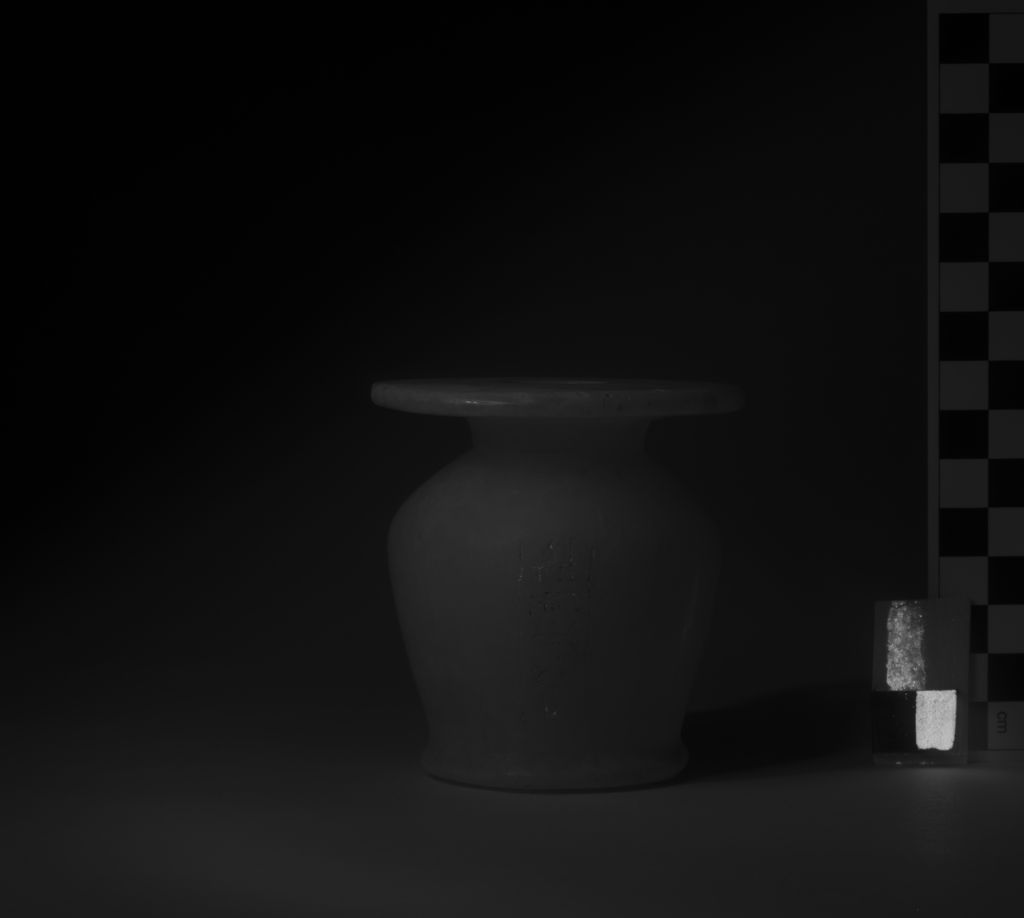
Inventory Number: Cat. 3255 (Figs. 10, 20, 21, 22)
Material: Calcite alabaster, Egyptian blue
Dimensions: height: 7.2; width from lug to lug: 13.2 cm; width without lugs: 11.7 cm; diam. of base: 3.9 cm; outer diam. of rim: 8.6 cm; inner diam. of rim: 6.6 cm; diam. of mouth: 6 cm; max. inner depth measured from upper rim: 5.5 cm; diam. of lid: 6.9 cm; thickness of lid: 0.72 cm; weight with lid: 1041.5 g; weight of lid: 53.8 g
Acquisition: before 1855 (possibly from Drovetti collection)
Provenance: unknown, probably Saqqara (see below)
Date: mid-18th Dynasty, Thutmose IV – Amenhotep III
Description: Calcite alabaster vessel with a short, flattened rim which is covered with a disc-shaped lid, round sloping shoulders, two summarily indicated and unpierced lugs, a globular (oblate spheroidal) squat body and a rounded base. The text
References: Orcurti, Catalogo illustrato, 1855, p. 178, N.5; Fabretti et al., Regio Museo I, 1882, p. 443, Cat. 3255; Faltings and Gessler-Löhr, in Spiekermann (ed.), FS Schmitz, 2008, p. 69, I.11.
Parallels: A general parallel for the shape can be found in RMO-Leiden AAL 51a, a coeval jar, slightly smaller and with a more pronounced angular rim, belonging to the high-priest of Ptah
Main views of Turin Cat. 3255 from four sides (photo by Nicola Dell’Aquila and Federico Taverni/Museo Egizio).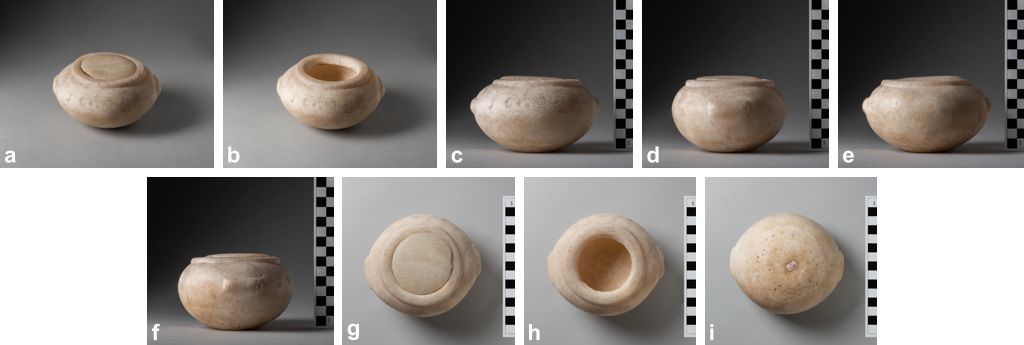
Two views of Turin Cat. 3255 with light shining through (photos by Nicola Dell’Aquila and Federico Taverni/Museo Egizio).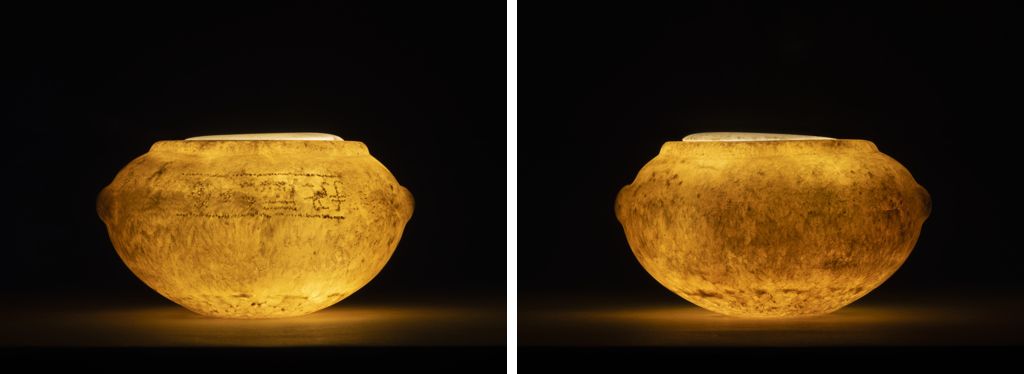
View of the inscription of Cat. 3255 under visible induced luminescence (VIL) (photo by Nicola Dell’Aquila and Federico Taverni/Museo Egizio).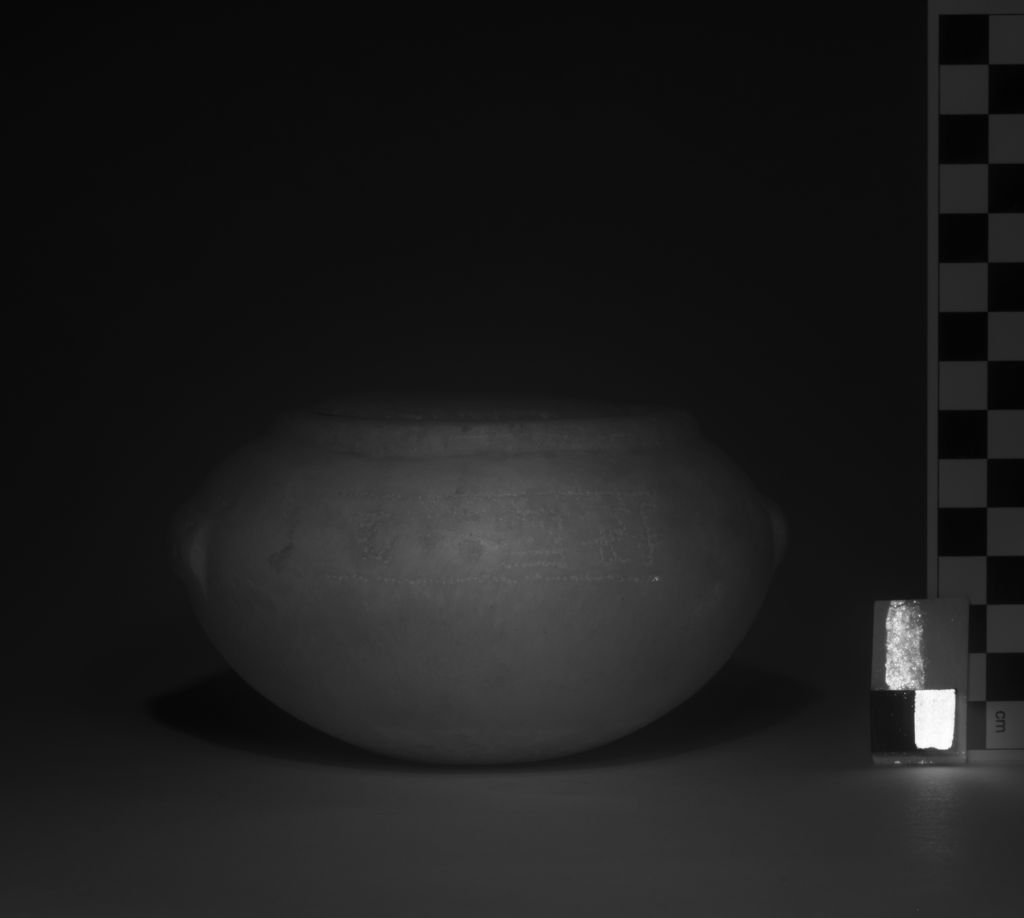
4. Additional Comments on Provenance
Next to the long-debated dating issue which could be solved by Faltings and Gessler-Löhr and is also supported by typological and archaeologically provenanced parallels,34 the question of the archaeological provenance of the calcite alabaster vessels and the cosmetic implement remains. Faltings and Gessler-Löhr could show that the stela of
For the Turin vessels, the date of acquisition and thus presence in the Regio Museo in Piemonte’s capital is “before 1855”, the publication year of Orcurti’s catalogue. Yet they do not necessarily belong to the Drovetti collection, which is, however, very likely.37 The 1822 Catalogo Sommario dei monumenti antichi egiziani componenti la collezione di cose Egizie del Cavaliere Drovetti contains a list of 90 “Vasi ed oggetti in Alabastro”.38 Among them, the most likely candidates for an identification with the vessels of
Calcite alabaster vessels in the Drovetti list from 1820 (published in 1822) among which the vessels of
Drovetti nos.
Description
23–25
Vases avec hiéroglyphes
35
Idem id. (= sans anse) avec petit couvercle, et hiéroglyphes sur le devant; 10 c.
36
Idem id.; 12 c.
37
Idem avec hiéroglyphes; 8 c.
38
Idem; 11 c.
39
Idem; 4 c.
40
Idem; 5 c.
45
Vase petit sans couvercle, avec quelques hiéroglyphes sur le devant.
59
Vase avec son couvercle et hiéroglyphes sur le devant.
61
Idem id. (= plus petit vase avec son couvercle) avec hiéroglyphes.
66
Vase avec hiéroglyphes sur le devant.
The link between the calcite alabaster vessels of
5. Final Remarks
The currently known set of cosmetic jars certainly belonging to the funerary equipment of the princess
Besides addressing questions about the chaine opératoire of stone vessel manufacture, which are outside the scope of the present article,51 future research on the vessels of
From left to right: Cat. 3256 (3.8 × 10.2 cm; rim diam. 3.1 cm); Cat. 3250 (9.42 × 9.7 cm; outer neck diam. 4.5 cm); Cat. 3249 (12.1 × 7 cm [max. outer diam. at lower open base]; outer neck diam. 3.8; Cat. 3251 (8.4 × 7.6 cm; neck diam. 5.1 cm; outer rim diam. 6.72 cm and lower base diam. 4.35 cm).![From left to right: Cat. 3256 (3.8 × 10.2 cm; rim diameter 3.1 cm); Cat. 3250 (9.42 × 9.7 cm; outer neck diameter 4.5 cm); Cat. 3249 (12.1 × 7 cm [maximum outer diameter at lower open base]; outer neck diameter 3.8; Cat. 3251 (8.4 × 7.6 cm; neck diameter 5.1 cm; outer rim diameter 6.72 cm and lower base diameter 4.35 cm).](https://rivista.museoegizio.it/wp-content/uploads/2023/01/fig-23-site.jpg)
From left to right: Cat. 3252 (7.35 × 8.3 cm [outer rim diam.]; body diam. 6.8 cm; base diam. 6.55 cm); Cat. 3253 (6.9 × 8.5 cm [outer rim diam.]; body diam. 6.8 cm; base diam. 6.5 cm).![From left to right: Cat. 3252 (7.35 × 8.3 cm [outer rim diameter]; body diameter 6.8 cm; base diameter 6.55 cm); Cat. 3253 (6.9 × 8.5 cm [outer rim diameter]; body diameter 6.8 cm; base diameter 6.5 cm).](https://rivista.museoegizio.it/wp-content/uploads/2023/01/fig-24-site.jpg)
6. Acknowledgements
The author wants to thank the two anonymous reviewers for their insightful comments and detailed recommendations to improve the present work. Further warm thanks are due to Beatrix Geßler-Löhr, Melanie Flossmann-Schütze, Valentina Brambilla, Roberta Accordino, Kerstin Seidel, Francisco Bosch-Puche, Jan Dahms, Dietrich Raue, Tommaso Montonati, Federico Taverni, Nicola Dell’Aquila and Bianca Ciatti for further data, illustrations (including publication permissions), discussion and various forms of help and assistance during the work on this paper. Finally, Federico Poole, Divina Centore and (Paolo Bonacini) are thanked for their contributions to the smooth publication process.
7. Bibliography
Anonymous, “Collezione Drovetti, a. 1822. Catalogue de la collect. d’antiq. de mons. le chev. Drovetti”, in: Documenti inediti per servire alla storia dei musei d’Italia III, Firenze 1880, pp. 206–92.
Aston, Barbara G., Ancient Egyptian Stone Vessels: Materials and Forms (SAGA 5), Heidelberg 1994.
Bickel, Susanne, “Die Gräber KV 40 und KV 64 in der 18. Dynastie”, in: Susanne Bickel (ed.), Räuber – Priester – Königskinder. Die Gräber KV 40 und KV 64 im Tal der Könige: Die beschrifteten Objekte der 18. Dynastie und die Keramik (Swiss Egyptological Studies 2.1), Basel 2021, pp. 25–47.
Bierbrier, Morris. L., Hieroglyphic Texts from Egyptian Stelae, etc., Part 12, London 1993.
Bouvier, Guillaume, “Les princesses de Gourna,” in: Dieter Kessler, Regine Schulz, Alexandra Verbovsek, Stefan J. Wimmer and Martina Ullmann (eds.), Texte – Theben – Tonfragmente: Festschrift für Günter Burkard (ÄAT 76), Wiesbaden 2009, pp. 59–69.
Budka, Julia, Tomb 26 on Sai Island: A New Kingdom Elite Tomb and its Relevance for Sai and Beyond. With contributions by Johannes Auenmüller, Cajetan Geiger, Rennan Lemos, Andrea Stadlmayr and Marlies Wohlschlager, Leiden 2021.
Champollion, Jean-François, Notice descriptive des monuments égyptiens du musée Charles X, edited by Sylvie Guichard, Paris 2013.
Chassinat, Émile, “La princesse Noubemtekh,” REA 1 (1927), p. 132.
Donatelli, Laura, “Rassegna dei reperti egizi elencati nelle 106 pagine del manoscritto”, in: Alle origini dell’Egittologia e del primo Museo Egizio della storia: Torino 1820–1832 (MATur 5.43), Torino 2019, pp. 79–118.
El-Khouli, Ali, Egyptian Stone Vessels. Predynastic Period to Dynasty III. Typology and Analysis. 3 vols. (SDAIK 5), Mainz 1978.
Fabretti, Ariodante, Francesco Rossi and Ridolfo Vittorio Lanzone, Regio Museo di Torino. Antichità Egizie (Catalogo generale dei musei di antichità e degli oggetti d’arte raccolti nelle gallerie e biblioteche del regno 1. Piemonte), vol. I, Torino 1882.
Faltings, Dina and Beatrix Gessler-Löhr, “Eine Königstochter und ein Königssohn aus der 18. Dynastie”, in: Antje Spiekermann (ed.), „Zur Zierde gereicht…“: Festschrift Bettina Schmitz zum 60. Geburtstag am 24. Juli 2008 (HÄB 50), Hildesheim 2008, pp. 63–89.
Garstang, John, Maḥâsna and Bêt Khallâf (BSAE 7), London 1903.
Gauthier, Henri, “Quelques additions au ‘Livre des rois d’Égypte’ (Ancien et Moyen Empire)”, RecTrav 40 (1923), pp. 177–204.
Giovetti, Paola and Picchi, Daniela (eds.), Egypt – Millenary Splendour: The Leiden Collection in Bologna, Milan 2016.
Herzberg-Beiersdorf, Anne, Prosopographia Memphitica: Individuelle Identitäten und kollektive Biographien einer königlichen Residenzstadt des Neuen Reichs (ZÄS-Beih. 15), Berlin 2023.
Hirsch, Eileen, “Die Beziehungen der ägyptischen Residenz im Neuen Reich zu den vorderasiatischen Vasallen. Die Vorsteher der nördlichen Fremdländer und ihre Stellung bei Hofe”, in: Rolf Gundlach and Andrea Klug (eds.), Der ägyptische Hof des Neuen Reiches. Seine Gesellschaft und Kultur im Spannungsfeld zwischen Innen- und Außenpolitik. Akten des Internationalen Kolloquiums vom 27.-29. Mai 2002 an der Johannes-Gutenberg-Universität Mainz (KSG 2), Wiesbaden 2006, pp. 119–99.
Jansen-Winkeln, Karl, “Ein Schminkgefäß und ein General”, ZÄS 143.2 (2016), pp. 194–203.
Kawai, Nozomu, “The tomb of Isisnofret at Northwest Saqqara”, in: Miroslav Bárta, Filip Coppens and Jaromír Krejčí (eds.), Abusir and Saqqara in the Year 2010, Vol. 2, Prague 2011, pp. 497–511.
Kozloff, Arielle P., “Egyptian Stone Vessels in Cleveland,” BCMA 73.8 (1986), pp. 327–39.
Klemm, Dietrich and Rosemarie Klemm, “Calcit-Alabaster oder Travertin? Bemerkungen zu Sinn und Unsinn petrographischer Bezeichnungen in der Ägyptologie”, GM 122 (1991), pp. 57–70.
Lilyquist, Christine, “The Gold Bowl Naming General Djehuty: A Study of Objects and Early Egyptology”, MMJ 23 (1988), pp. 5–68.
Lilyquist, Christine, Egyptian Stone Vessels: Khian through Tuthmosis IV, New York 1995.
Lilyquist, Christine, The Tomb of Three Foreign Wives of Tuthmosis III, New Haven, CT, 2003.
Litherland, Piers, The Western Wadis of the Theban Necropolis: A Re-Examination of the Western Wadis of the Theban Necropolis by the Joint-Mission of the Cambridge Expedition to the Valley of the Kings and the New Kingdom Research Foundation, 2013–2014, London 2014.
Litherland, Piers, The Shaft Tombs of Wadi Bairiya, Volume I: Preliminary Report on the Clearance Work on the WB1 Site by the Joint-Venture Mission of the New Kingdom Research Foundation with the Ministry of Antiquities, London 2018.
Maspero, Gaston, “Rapport à M. Jules Ferry, Ministre de l’Instruction Publique, sur une mission en Italie (suite)”, RecTrav 4 (1883), pp. 125–51.
Orcurti, Pier Camillo, Catalogo illustrato dei monumenti egizii del R. Museo di Torino compilato dal professore Pier Camillo Orcurti, Vol. II, Torino 1855.
Poole, Federico, “Flawed and Fine? The Statue of Hel in the Museo Egizio, Turin (Cat. 7352)”, RiME 3 (2019). DOI: 10.29353/rime.2019.2808
Reeves, Nicholas, “The Ashburnham Ring and the Burial of General Djehuty”, JEA 79.1 (1993), pp. 259–61.
Reisner, George A., Mycerinus: The Temples of the Third Pyramid at Giza, Cambridge (MA) 1931.
Roccati, Alessandro, “La riscoperta continua dell’Egitto: ‘preistoria‘ delle collezioni torinesi”, in: Silvio Curto, Cristina Morigi Govi and Sergio Pernigotti (eds.), L’Egitto fuori dell’Egitto: dalla riscoperta all’Egittologia, Bologna 1991, pp. 357–66.
Roccati, Alessandro, “Riscoperta e scavi delle antichità in Egitto”, in: Alle origini dell’Egittologia e del primo Museo Egizio della storia: Torino 1820-1832 (MATur 5.43), Torino 2019, pp. 7–26.
Staring, Nico, “The Mid-Nineteenth Century Exploration of the Saqqara New Kingdom Necropolis”, in Vincent Verschoor, Arnold Jan Stuart and Cocky Demarée (eds.), Imaging and Imagining the Memphite Necropolis: Liber Amicorum René van Walsem (EU 30), Leiden 2017, pp. 95–113.
Steindorff, Georg, Aniba. Zweiter Band (Mission archéologique de Nubie 1929–1934), Glückstadt 1937.
Stocks, Denys A., “Making Stone Vessels in Ancient Mesopotamia and Egypt”, Antiquity 67 (256) (1993), pp. 596–603. doi:10.1017/S0003598X00045804
Stocks, Denys A., Experiments in Egyptian Archaeology: Stoneworking Technology in Ancient Egypt, London 2003.
Notes
- Faltings and Gessler-Löhr, in Spiekermann (ed.), <i>FS Schmitz</i>, 2008, pp. 63–89; see also Bierbrier, <i>Hieroglyphic Texts</i> 12, 1993, p. 26, on the monuments of <named-content content-type="traslitterazione-unicode">Nbw-m-tḫ</named-content> with references to their earlier mentions or publications (such as Chassinat, <i>REA</i> 1 [1925], p. 132, who dates the princess, based on <b>I.9</b>, <b>I.5</b> and <b>II</b> [see Table 1], to the second half of the Old Kingdom or the Middle Kingdom). Vessels <b>I.1</b> and <b>I.4</b> are discussed by Valentina Gasperini in Giovetti and Picchi (eds.), <i>Egypt – Millenary Splendour</i>, 2016, pp. 353 and 547, cat.-nos VI.48a–b (and are dated there to the reigns of Amenhotep II – Thutmose IV). Vessel <b>I.5</b> is mentioned in Champollion, <i>Notice descriptive</i>, 2013, p. 214, no. L. 55 (and is dated there to beginning of the 18<sup>th</sup> Dynasty). Finally, see also Anne Herzberg-Beiersdorf, Prosopographia Memphitica, <a href="https://anneherz.github.io/ProM/detail/singleview_objects.html?ids=230">https://anneherz.github.io/ProM/detail/singleview_objects.html?ids=230</a> (last access 31 January 2023) on stelae BM EA 1369 with a brief list of the previously known constituents of <named-content content-type="traslitterazione-unicode">Nbw-m-tḫ</named-content>'s prosopographical dossier.↑
- The stone variety the vessels are made from is called “calcite alabaster” throughout this paper following the suggestions by Klemm and Klemm, <i>GM</i> 122 (1991), pp. 57–70.↑
- All data from Faltings and Gessler-Löhr, in Spiekermann (ed.), <i>FS Schmitz</i>, 2008, pp. 64–70. The links to the respective museum collection online databases in the following footnotes provide further information on the objects, particularly in terms of older publications or mentions.↑
- For a discussion of the name, see Faltings and Gessler-Löhr, in Spiekermann (ed.), <i>FS Schmitz</i>, 2008, pp. 74.↑
- <a href="https://hdl.handle.net/21.12126/2848">https://hdl.handle.net/21.12126/2848</a> (last access 2 August 2022).↑
- <a href="https://hdl.handle.net/21.12126/2845">https://hdl.handle.net/21.12126/2845</a> (last access 2 August 2022).↑
- <a href="https://hdl.handle.net/21.12126/2780">https://hdl.handle.net/21.12126/2780</a> (last access 2 August 2022).↑
- <a href="https://collections.louvre.fr/ark:/53355/cl010008145">https://collections.louvre.fr/ark:/53355/cl010008145</a> (last access 2 August 2022).↑
- Actually, the Louvre online collection data informs that the year of arrival at the Louvre is 1827, while the piece was entered into the inventory on 16 February 1857.↑
- Faltings and Gessler-Löhr, in Spiekermann (ed.), <i>FS Schmitz</i>, 2008, p. 67, fn. 35.↑
- <a href="https://www.britishmuseum.org/collection/object/Y_EA4536">https://www.britishmuseum.org/collection/object/Y_EA4536</a> (last access 2 August 2022).↑
- <a href="https://collections.louvre.fr/ark:/53355/cl010027607">https://collections.louvre.fr/ark:/53355/cl010027607</a> (last access 2 August 2022).↑
- The data under <a href="https://collections.louvre.fr/en/ark:/53355/cl010027607">https://collections.louvre.fr/en/ark:/53355/cl010027607</a> informs that this piece was inventoried in 1832. ↑
- <a href="https://www.britishmuseum.org/collection/object/Y_EA1369">https://www.britishmuseum.org/collection/object/Y_EA1369</a> (last access 2 August 2022). For this stela and its prosopographical data, see also Anne Herzberg-Beiersdorf, Prosopographia Memphitica, <a href="https://anneherz.github.io/ProM/detail/singleview_objects.html?ids=230">https://anneherz.github.io/ProM/detail/singleview_objects.html?ids=230</a> (last access 31 February 2023).↑
- Faltings and Gessler-Löhr, in Spiekermann (ed.), <i>FS Schmitz</i>, 2008, p. 63, fn. 4.↑
- Orcurti, <i>Catalogo illustrato</i> II, 1855.↑
- Orcurti, <i>Catalogo illustrato</i> II, 1855, pp. 178–179.↑
- As already remarked by Faltings and Gessler-Löhr, in Spiekermann (ed.), <i>FS Schmitz</i>, 2008, p. 69, fn. 51, Orcurti seemingly overlooked the feminine ending in the title and misunderstood the sign Gardiner W 23 (vessel classifier) as F 34 (heart-sign), thus reading a male title and name.↑
- See the guidelines of the <i>Rivista del Museo Egizio</i> <a href="https://rivista.museoegizio.it/pubblica-con-noi/">https://rivista.museoegizio.it/pubblica-con-noi/</a> for the different inventory number systems in use at the Museo Egizio, Turin.↑
- In fact, these catalogue numbers are also cited by Faltings and Gessler-Löhr, in Spiekermann (ed.), <i>FS Schmitz</i>, 2008, pp. 67–68, fns. 38 and 43, in their references to Fabretti et al., <i>Regio Museo</i> I, 1882.↑
- This number specifying the position and location of the objects in the original showcases is also found at the end of each entry in Fabretti et al., <i>Regio Museo</i> I, 1882 (see Figs. 13–16). Today, those stickers are not present anymore. In the case of <b>I.8</b> (= Cat. 3248), the location number is written in pencil on the base, while <b>I.12</b> (= Cat. 3254) now has the sticker on the base.↑
- For these archive materials, see <a href="https://archive.griffith.ox.ac.uk/index.php/petrie-3-2">https://archive.griffith.ox.ac.uk/index.php/petrie-3-2</a> (last access 5 October 2022). ↑
- See <a href="https://archive.griffith.ox.ac.uk/index.php/petrie-3-1-190">https://archive.griffith.ox.ac.uk/index.php/petrie-3-1-190</a> and <a href="https://archive.griffith.ox.ac.uk/index.php/petrie-3-1-195">https://archive.griffith.ox.ac.uk/index.php/petrie-3-1-195</a> (last access 5 October 2022).↑
- Faltings and Gessler-Löhr, in Spiekermann (ed.), <i>FS Schmitz</i>, 2008, pl. VII, figs. 8–9.↑
- Cf. the more elaborate calcite alabaster (ritual model) <i>nemset</i>-vessel of the high-priest of Ptah <named-content content-type="traslitterazione-unicode">Ptḥ-ms</named-content> Leiden RMO-AAL 50 (<a href="https://hdl.handle.net/21.12126/356">https://hdl.handle.net/21.12126/356</a>; last access 2 August 2022) as a loose parallel dating to the time of Amenhotep III. ↑
- Steindorff, <i>Aniba</i> II, 1937, p. 144 and pl. 95.9 (already referred to by Faltings and Gessler-Löhr, in Spiekermann [ed.], <i>FS Schmitz</i>, 2008, p. 67, fn. 40). This vessel is kept at the Egyptian Museum – Georg Steindorff – of Leipzig University under the inventory number UL Egypt 6060 (<a href="https://sammlungen-editor.uni-leipzig.de/receive/ULEgypt_lido_00006332">https://sammlungen-editor.uni-leipzig.de/receive/ULEgypt_lido_00006332</a>; last access 8 February 2023).↑
- Steindorff, <i>Aniba</i> II, 1937, p. 145 and pl. 95.23. This vessel is kept at the Egyptian Museum – Georg Steindorff – of Leipzig University under the inventory number UL Egypt 6067 (<a href="https://sammlungen-editor.uni-leipzig.de/receive/ULEgypt_lido_00006339">https://sammlungen-editor.uni-leipzig.de/receive/ULEgypt_lido_00006339</a>; last access 8 February 2023). Possibly the vessel Cleveland Museum of Art 1914.620, resembling an ostrich egg with a smoothed elevated mouth, can also be cited as parallel (Kozloff, <i>BCMA</i> 73.8 [1986], p. 335, figs. 26–27; <a href="https://www.clevelandart.org/art/1914.620">https://www.clevelandart.org/art/1914.620</a>). Given the comparable dimensions and shape, the neck of this vessel could have been removed and the remaining part smoothed to create the rounded external rim.↑
- Budka, <i>Tomb 26</i>, 2021, pp. 107–109, fig. 5.30.↑
- Cf. also the additional parallels mentioned in Faltings and Gessler-Löhr, in Spiekermann (ed.), <i>FS Schmitz</i>, 2008, pp. 63–79.↑
- Staring in Giovetti and Picchi (eds.), <i>Egypt – Millenary Splendour</i>, pp. 267, 529–30, cat-no. V.29; <a href="https://hdl.handle.net/21.12126/18813">https://hdl.handle.net/21.12126/18813</a> (last access 2 August 2022).↑
- Lilyquist, <i>Three Foreign Wives</i>, 2003, pp. 245–46; 256–57, figs. 199–200, Cat. 168 (14.2 cm in height, 22 cm in diam.; the body is thicker and transition to base more “swollen”). See also Lilyquist, <i>Stone Vessels</i>, 1995, pp. 10–12; Aston, <i>Stone Vessels</i>, 1994, p. 131 with form 108. See also the “type 3–III spheroidal jar with horizontal handles” made of hard stones in Reisner, <i>Mycerinus</i>, 1931, p. 185, fig. 55, no. 21, next to the 2<sup>nd</sup> Dynasty porphyry pieces in El-Khouli, <i>Egyptian Stone Vessels</i>, Vol. III, 1974, pl. 84, nos. 2259, 2260 and 2261.↑
- Cf., as a chronological and typological parallel, the “coarse alabaster” vessel from Beit Khallaf mastaba K2: Garstang, <i>Mahasna</i>, pl. XX. ↑
- <a href="https://www.metmuseum.org/art/collection/search/545769">https://www.metmuseum.org/art/collection/search/545769</a> (last access 10 November 2021). The practice of reuse is evidenced by several other stone vessels, see, e.g., Lilyquist, <i>Stone Vessels</i>, 1995, pp. 10–12; Jansen-Winkeln, <i>ZÄS</i> 143 (2016), pp. 194–203 (including further references to similar cases).↑
- The dating of vessels <b>I.1</b> and <b>I.4</b> in Giovetti and Picchi (eds.), <i>Egypt – Millenary Splendour</i>, 2016, pp. 353 and 547, cat.-nos VI.48a–b to the reigns of Amenhotep II – Thutmose IV as well as the dating of vessel <b>I.5</b> in Champollion, <i>Notice descriptive</i>, 2013, p. 214, no. L. 55, to the beginning of the 18<sup>th</sup> Dynasty thus need to be revised.↑
- Faltings and Gessler-Löhr, in Spiekermann (ed.), <i>FS Schmitz</i>, 2008, pp. 77–78. For the most recent overview of the prosopography of Memphis in the New Kingdom, see Herzberg-Beiersdorf, <i>Prosopographia Memphitica</i>, 2023 and the corresponding online database <a href="https://www.prosopographia-memphitica.com">https://www.prosopographia-memphitica.com</a>.↑
- Cf. Lilyquist, <i>MMJ</i> 23 (1988), pp. 5–68. See also Staring, in Verschoor et al. (eds.), <i>Imaging and Imagining</i>, 2017, pp. 95–113, for the mid-19<sup>th</sup> century exploration of Saqqara.↑
- Particular thanks are due to my colleague Tommaso Montonati for further information about the Drovetti collection and objects from other smaller collections (Donati, Sossio, Busca, Bussi, Zucchi, etc.) in the Museo Egizio which are also included in Fabretti et al., <i>Regio Museo</i> I–II, 1882–1888. ↑
- Anonymous, in <i>Documenti inediti</i>, 1880, pp. 272–74; on this document, see also Donatelli, in: <i<Alle origini dell’Egittologia</i>, 2019, pp. 79–118.↑
- On <named-content content-type="traslitterazione-unicode">Ḏḥw.tj</named-content> and his monuments, see, e.g., Lilyquist, <i>MMJ</i> 23 (1988), pp. 5–68; Reeves, <i>JEA</i> 79 (1993), pp. 259–61; Hirsch, in Gundlach und Klug (eds.), <i>Der ägyptische Hof</i>, 2006, pp. 123–26; 183–84. The model scribal palette of <named-content content-type="traslitterazione-unicode">Ḏḥw.tj</named-content> Turin Cat. 6227 can be identified in the Drovetti list with no. 85 without an asterisk. The alabaster vessels of <named-content content-type="traslitterazione-unicode">Ḏḥw.tj</named-content> Turin Cat. 3225, 3226, 3227 and 3228 (possibly also Cat. 3234 numero doppio) might be amongst the Drovetti list numbers *74–*80 (*79 = Cat. 3227 and *80 = Cat. 3226). The presence of the asterisk with these numbers indicates that they were added post-September 1820 to the object list. For a discussion of objects from Saqqara as part of the Drovetti collection, see also Poole, in <i>RiME</i> 3 (2019) pp. 13-14. <a href="https://rivista.museoegizio.it/article/flawed-and-fine-the-statue-of-hel-in-the-museo-egizio-turin-cat-7352/ ">https://rivista.museoegizio.it/article/flawed-and-fine-the-statue-of-hel-in-the-museo-egizio-turin-cat-7352/ </a>.↑
- Lilyquist, <i>MMJ</i> 23 (1988), pp. 5–68.↑
- Lilyquist, <i>MMJ</i> 23 (1988), p. 65 mentions that the Turin <named-content content-type="traslitterazione-unicode">Ḏḥw.tj</named-content> objects might even have left Egypt before 1818.↑
- Reeves, <i>JEA</i> 79 (1993), pp. 259–61.↑
- Roccati, in <i>Alle origini dell’Egittologia</i>, 2019, passim.↑
- Roccati, in <i>Alle origini dell’Egittologia</i>, 2019, p. 23.↑
- See Bouvier, in Kessler et al. (eds.), <i>Texte – Theben – Tonfragmente</i>, 2009, pp. 59–69; Litherland, <i>Shaft Tombs of Wadi Bairiya</i>, 2018; Bickel, in Bickel (ed.), <i>Räuber – Priester – Königskinder</i>, 2021, pp. 28–38. Lilyquist, <i>Three Foreign Wives</i>, 2003, and Litherland, <i>Western Wadis</i>, 2014, offer further data.↑
- Kawai, in Bárta et al., <i>Abusir and Saqqara 2010/2</i>, 2011, pp. 497–510.↑
- Since Turin Cat. 3255 was not known to Faltings and Gessler-Löhr, in Spiekermann (ed.), <i>FS Schmitz</i>, 2008, pp. 70–73, they only subdivide the calcite alabaster vessels into three typological groups.↑
- Future residue analyses might elucidate their function and contents more precisely.↑
- If the information provided by Roccati, in Morigi Govi et al. (eds.), <i>L’Egitto fuori dell’Egitto</i>, 1991, p. 362 and Roccati, in <i>Alle origini dell’Egittologia</i>, 2019, p. 23, is correct (Roccati twice references “cat. 3247 ss.”), other calcite alabaster vessels following Cat. 3247 and 3248 might also belong to the “corredo funerario” (burial assemblage) of the king’s daughter <named-content content-type="traslitterazione-unicode">Nbw-m-tḫ</named-content>. See also the following footnote.↑
- Since Cat. 3254 and Cat. 3255 belong to <named-content content-type="traslitterazione-unicode">Nbw-m-tḫ</named-content>’s funerary equipment for sure, some of the numbers in between Cat. 3248 and Cat. 3254 (and possibly a few numbers above Cat. 3255) might be grave goods of the princess as well.↑
- See Stocks, <i>Antiquity 67</i> (256) (1993), pp. 596–603; Stocks, <i>Experiments</i>, 2003, pp. 139–68.↑
- Cf. Stocks, <i>Experiments</i>, 2003, pp. 25–30; 63–66; 74–95. ↑










